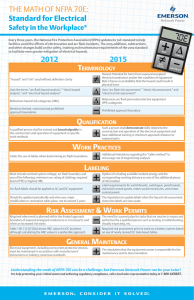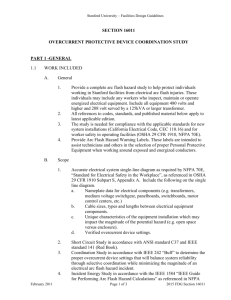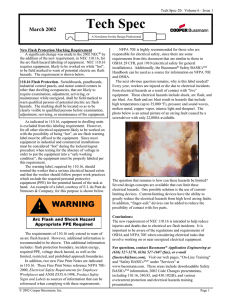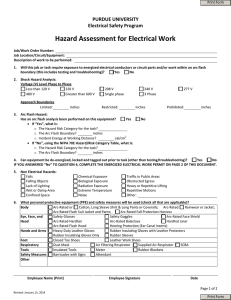NFPA 70E Updates Affect Your Most Valuable Assets
advertisement
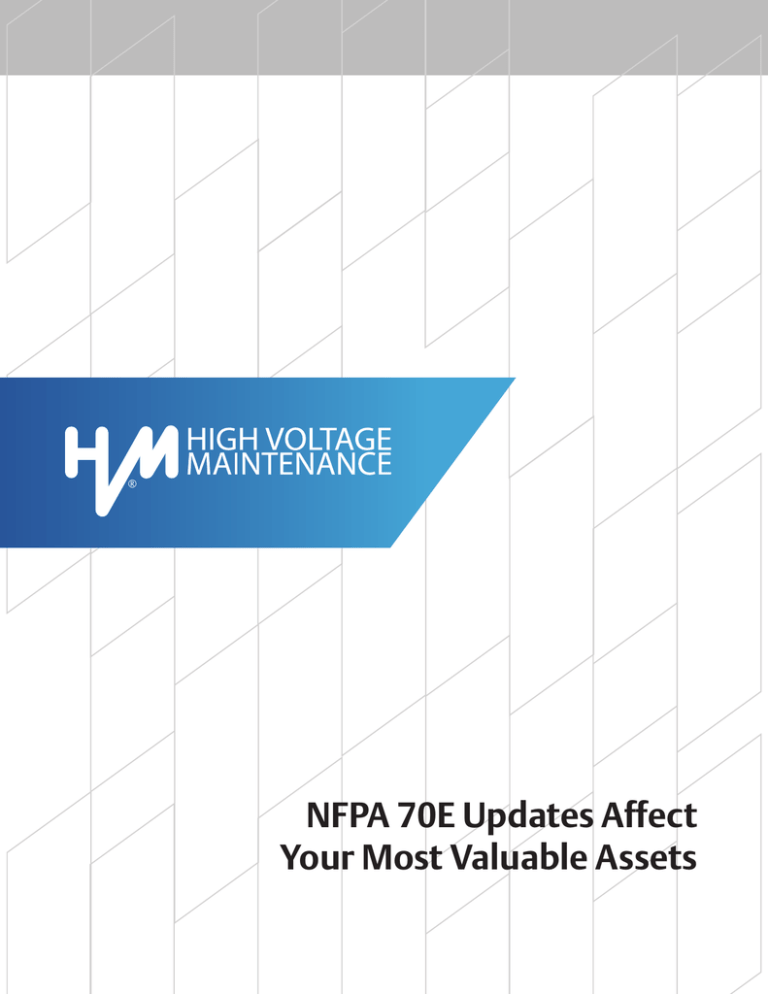
® NFPA 70E Updates Affect Your Most Valuable Assets NFPA 70E Updates Affect Your Most Valuable Assets EXECUTIVE SUMMARY Electrocution is a well-known hazard associated with direct contact with electrical energy. According to the U.S. Department of Labor, it is estimated that over 400 fatalities and nearly 10,000 serious injuries occur each year due to electrocution and arc flash incidents. Arc flash incidents alone are estimated to occur five to 10 times each day – resulting in a fatality every workday. To help prevent these type of electrical accidents, the recent 2015 version of the National Fire Protection Association (NFPA) 70E: Standard for Electrical Safety in the Workplace© makes essential updates in the areas of safety, maintenance, and training. While the importance of understanding electrical safety is clear, understanding the regulatory updates may not be. This paper aims to provide an overview and deeper understanding to safety and maintenance changes that impact facilities and electrical power infrastructures. NFPA 70E UPDATES AFFECT YOUR MOST VALUABLE ASSETS Arc Flash Hazards Recent changes in workplace safety have heightened the awareness of hazards associated with electrical arcs. Arcing from an electrical fault produces temperatures hotter than the surface of the sun. Arc flash is an electric current that is passed through the air when insulation or isolation between electrified conductors is not sufficient to withstand the applied voltage. The flash is immediate and the results can be severe. Far too often, employees are not properly equipped with the proper Personal Protective Equipment (PPE) in order to complete their jobs safely. Institute of Electrical and Electronics Engineers (IEEE) reports that 2,000 workers are admitted to burn centers for extended injury treatment caused by arc flash every year. Fortunately, both IEEE and the National Fire Protection Association (NFPA) recognize the serious ramifications related to arc flash and have joined together in order to support research, testing and public awareness. Arc Flash Risk Assessment A major revision in the 2015 NFPA 70E update states that the arc flash boundary distance must now be calculated for all locations where the voltage is greater than 50 volts and there is a possibility of performing energized work such as maintenance, diagnostics and testing. As noted in the new tables, revisions were also made in order to determine RISK (predicates use of PPE) and additional tables for determining proper PPE if required. 2 It is important to note that these tables provide basic guidelines for common tasks, but even the tables require system information that may or may not be known. If the task at hand is not located in the tables provided, or the system parameters defined in the tables are not met, an engineered analysis must be performed. Arc flash labeling became a 70E requirement in 2002. These requirements were updated in 2004, 2009, 2012, and 2015. While the wording in the 2009 edition only stated that electrical equipment had to be labeled, the 2015 edition clarifies the intent. NFPA 70E Updates Affect Your Most Valuable Assets NFPA 70E 130.5(D) states labels must include nominal system voltage, arc flash boundary, and at least one of the following: available incident energy and the corresponding working distance or the arc flash PPE category in Table 130.7(C)(15)(A)(b) or Table 130.7(C) (15)(B) for the equipment, but not both; minimum arc rating of clothing; and site specific level of PPE. Additionally, 130.5(D) states: “The method of calculating and the data to support the information for the label shall be documented. Where the review of the arc flash hazard risk assessment identifies a change that renders the label inaccurate, the label shall be updated. The owner of the electrical equipment shall be responsible for the documentation, installation, and maintenance of the field-marked label.” In years past, the standard regarding the supplied tables for arc flash boundary distance or whether the distance would have to be manually calculated were vague and not well-defined. Fortunately, provisions in the new 70E make it easier to define those boundaries. It is important to note that the Prohibited Approach Boundary has been removed from the standard. Article 130.4(B) states: “The shock protection boundaries identified as limited approach boundary and restricted approach boundary shall be applicable where approaching personnel are exposed to energized electrical conductors of circuit parts. With the updates in 2012, NFPA requires arc flash labeling for DC equipment. Table 130.4(D)(a) outlines the approach boundaries for AC equipment locations, and Table 130.4(D)(b) outlines the approach boundaries for DC equipment locations. APPROACH BOUNDARIES Any point on energized conductor or circuit part Arc Flash Boundary Restricted Approach Boundary Shock Protection Boundaries Limited Approach Boundary 3 NFPA 70E Updates Affect Your Most Valuable Assets Table 130.4(D)(a) Approach Boundaries to Energized Electrical Conductros or Circuit Parts for Shock Protection, for Alternating-Current Systems (1) (2) (3) (4) Limited Approach Boundaryb Nominal System Voltage Range, Phase to Phasea Exposed Movable Conductors Exposed Fixed Circuit Part Restricted Approach Boundaryb; Includes Inadvertent Movement Adder <50 V Not specified Not specified Not specified 50 V-50 V 3.0 m (10 ft 0 in.) 1.0 m (3 ft 6 in.) Avoid contact 151 V-750 V 3.0 m (10 ft 0 in.) 1.0 m (3 ft 6 in.) 0.3 m (1 ft 0 in.) d 751 V-15k V 3.0 m (10 ft 0 in.) 1.5 m (5 ft 0 in.) 0.7 m (2 ft 2 in.) 15.1 kV-36 kV 3.0 m (10 ft 0 in.) 1.8 m (6 ft 0 in.) 0.8 m (2 ft 7 in.) 36.1 kV-46 kV 3.0 m (10 ft 0 in.) 2.5 m (8 ft 0 in.) 0.8 m (2 ft 7 in.) 46.1 kV-72.5 kV 3.0 m (10 ft 0 in.) 2.5 m (8 ft 0 in.) 1.0 m (3 ft 3 in.) 72.6 kV-121 kV 3.3 m (10 ft 8 in.) 2.5 m (8 ft 0 in.) 1.0 m (3 ft 4 in.) 138 kV-145kV 3.4 m (11 ft 0 in.) 3.0 m (10 ft 0 in.) 1.2 m (3 ft 10 in.) 161 kV-169 kV 3.6 m (11 ft 8 in.) 3.6 m (11 ft 8 in.) 1.3 m (4 ft 3 in.) 230 kV-242 kV 4.0 m (13 ft 0 in.) 4.0 m (13 ft 0 in.) 1.7 m (5 ft 8 in.) 345 kV-362 kV 4.7 m (15 ft 4 in.) 4.7 m (15 ft 4 in.) 2.8 m (9 ft 2 in) 500 kV-550 kV 5.8 m (19 ft 0 in.) 5.8 m (19 ft 0 in.) 3.6 m (11 ft 10 in.) 765 kV-800 kV 7.2 m (23 ft 0 in.) 7.2 m (23 ft 0 in.) 4.9 m (15 ft 11 in.) Note (1): For arc flash boundary, see 130.5 (A) Note (2): All dimensions are distance from exposed energized electrical conductors or circuit part to employee. a For single-phase systems above 250V, select the range that is equal to the system’s maximun phase-to-ground voltage multiplied by 1.732. b See definition in Article 100 and text in 130.4(D)(2) and informative Annex C for elaboration. c Exposed movable conductors describes a condition in which the distance between the conductor and a person is not under the contro of the person. The term is normally applied to overhead line conductors supported by poles. d This includes circuits where the exposer does not exceed 120V. Table 130.4(D)(b) Approach Boundaries to Energized Electrical Conductros or Circuit Parts for Shock Protection, Direct-Current Voltage Systems (1) (2) (3) (4) Limited Approach Boundary Nominal Potential Difference Exposed Movable Conductorsa Exposed Fixed Circuit Part Restricted Approach Boundaryb; Includes Inadvertent Movement Adder <100 V Not specified Not specified Not specified 100 V-300 V 3.0 m (10 ft 0 in.) 1.0 m (3 ft 6 in.) Avoid contact 301 V-1 kV 3.0 m (10 ft 0 in.) 1.0 m (3 ft 6 in.) 0.3 m (1 ft 0 in.) 1.1 kV-5 kV 3.0 m (10 ft 0 in.) 1.5 m (5 ft 0 in.) 0.7 m (2 ft 2 in.) 5 kV-15 kV 3.0 m (10 ft 0 in.) 1.8 m (6 ft 0 in.) 0.8 m (2 ft 7 in.) 15.1 kV-45 kV 3.0 m (10 ft 0 in.) 2.5 m (8 ft 0 in.) 0.8 m (2 ft 7 in.) 45.1 kV-75 kV 3.0 m (10 ft 0 in.) 2.5 m (8 ft 0 in.) 1.0 m (3 ft 3 in.) 75.1 kV-150 kV 3.3 m (10 ft 8 in.) 2.5 m (8 ft 0 in.) 1.0 m (3 ft 4 in.) 150.1 kV-250 kV 3.4 m (11 ft 0 in.) 3.0 m (10 ft 0 in.) 1.2 m (3 ft 10 in.) 500.1 kV-800 kV 3.6 m (11 ft 8 in.) 3.6 m (11 ft 8 in.) 1.3 m (4 ft 3 in.) Note: All dimensions are distance from exposed energized electrical conductors to worker a Exposed movable conductors describes a condition in which the distance between the conductor and a person is not under the contro of the person. The term is normally applied to overhead line conductors supported by poles. 4 NFPA 70E Updates Affect Your Most Valuable Assets Proper PPE is important and life saving. Qualified persons must assess the risks involved in performing any task and dress accordingly. This holds true when utilizing PPE Category Tables or Arc Flash Hazard Warning Labels. New updates to the 2015 edition have incorporated a new format when choosing arc-rated clothing and PPE. Table 130.7 (C)(15)(A)(b) will be split into two tables. The first table is used to determine if an arc flash hazard exists. If an arc flash hazard is present, you must wear all of the required clothing and PPE. Table 130.7(C)(15)(A)(b) Arc-Flash Hazard PPE Categories for Alternating Current (ac) Systems Arc Flash PPE Category Arc-Flash Boundary Panelboards or other equipment rated 240 V and below Parameters: Maximum of 25 kA short-circuit current available; maximum of 0.03 sec (2 cycles) fault clearing time; working distance 455 mm (18 in.) 1 485 mm (19 in.) Panelboards or other equipment rated 240 V and up to 600 V Parameters: Maximum of 25 kA short-circuit current available; maximum of 0.03 sec (2 cycles) fault clearing time; working distance 455 mm (18 in.) 2 900 mm (3 ft) 600-V class motor control centers (MCCs) Parameters: Maximum of 65 kA short-circuit current available; maximum of 0.03 sec (2 cycles) fault clearing time; working distance 455 mm (18 in.) 2 1.5 m (5 ft) 600-V class motor control centers (MCCs) Parameters: Maximum of 42 kA short-circuit current available; maximum of 0.33 sec (20 cycles) fault clearing time; working distance 455 mm (18 in.) 4 4.3 m (14 ft) 600-V class switchgear (with power circuit breakers or fused switches) and 600 V class switchboards Parameters: Maximum of 35 kA short-circuit current available; maximum of 0.5 sec (30 cycles) fault clearing time; working distance 455 mm (18 in.) 4 6 m (20 ft) Other 600-V class (277 V through 600 V, nominal) equipment Parameters: Maximum of 65 kA short-circuit current available; maximum of 0.03 sec (2 cycles) fault clearing time; working distance 455 mm (18 in.) 2 1.5 m (5 ft) NEMA E2 (fused contactor) motor starters, 2.3 kV through 7.2 kV Parameters: Maximum of 35 kA short-circuit current available; maximum of 0.24 sec (15 cycles) fault clearing time; working distance 910 mm (36 in.) 4 12 m (40 ft) Metal-clad switchgear, 1 kV through 15 kV Parameters: Maximum of 35 kA short-circuit current available; maximum of 0.24 sec (15 cycles) fault clearing time; working distance 910 mm (36 in.) 4 12 m (40 ft) N/A ( doors closed) N/A (doors closed) 4 12 m (40 ft) Equipment Arc-resistant switchgear Type 1 or 2 [for clearing times of ˂ 0.5 sec (30 cycles) with a perspective fault current not to exceed the arc-resistant rating of the equipment], and metal-enclosed interrupter switchgear, fused or unfused of arc-resistant-type construction, tested in accordance with IEEE C37.20.7, 1 kV through 15 kV Parameters: Maximum of 35 kA short-circuit current available; maximum of 0.24 sec (15 cycles) fault clearing time; working distance 910 mm (36 in.) Other equipment 1 kV through 15 kV Parameters: Maximum of 35 kA short-circuit current available; maximum of 0.24 sec (15 cycles) fault clearing time; working distance 910 mm (36 in.) Note: For equipment rated 600 volts and below, and protected by upstream current-limiting fuses or current-limiting circuit breakers sized at 200 amperes or less, the arc flash PPE category can be reduced by one number but not below arc flash PPE category 1. Table 130.7(C)(15)(A)(b) illustrates the arc flash hazard PPE categories. 5 NFPA 70E Updates Affect Your Most Valuable Assets Table 130.7(C)(15)(B) Arc-Flash Hazard PPE Categories for Direct Current (dc) Systems Arc Flash PPE Category Arc-Flash Boundary Short-circuit current < 4 kA 1 900 mm (3 ft) 4 kA ≤ short-circuit current < 7 kA 2 1.2m (4 ft) 7 kA ≤ short-circuit current < 15 kA 3 1.8 m (6 ft) Short-circuit current 1.5 kA 1 900 mm (3 ft) 1.5 kA ≤ short-circuit current < 3 kA 2 1.2 m (4 ft) 3 kA ≤ short-circuit current < 7 kA 3 1.8 m (6 ft) 7 kA ≤ short-circuit current < 10 kA 4 2.5 m (8 ft) Equipment Storage batteries, dc switchboards, and other dc supply sources 100 V > Voltage< 250 V Parameters: Voltage: 250 V Maximum arc duration and working distance: 2 sec @ 455 mm (18 in.) Storage batteries, dc switchboards, and other dc supply sources 250 V ≤ Voltage ≤ 600 V Parameters: Voltage: 600 V Maximum arc duration and working distance: 2 sec @ 455 mm (18 in.) Note: Apparel that can be expected to be exposed to electrolyte must meet both of the following conditions: (1) Be evaluated for electrolyte protection in accordance with ASTM F1296, Standard Guide for Evaluating Chemical Protective Clothing (2) Be arc-rated in accordance with ASTM F1891, Standard Specification for Arc Rated and Flame Resistant Rainwear, or equivalent The Informative Annex H in NFPA 70E provides guidelines in relation to proper clothing and personal protective equipment (PPE) regardless of whether the arc flash PPE category method or the incident energy method is used to perform an arc flash risk assessment. Additionally, it also provides guidance for the selection of shock protective equipment. Tables 130.7 (C)(15)(A)(b), 130.7 (C)(15)(B), and 130.7 (C)(16) are only applicable when using the arc flash PPE category method to perform an arc flash risk assessment for alternating current (ac) or direct current (dc) systems. It also states that the arc flash PPE categories may be applicable when using the incident energy method to perform an arc flash risk assessment. When performing an incident energy analysis, the arc flash labels created may include an arc flash PPE category. 6 NFPA 70E Updates Affect Your Most Valuable Assets Table 130.7(C)(16) Personal Protective Equipment (PPE) PPE Category PPE 1 Arc-Rated Clothing, Minimum Arc Rating of 4 cal/cm2 (see Note 1) Arc-rated long-sleeve shirt and pants of arc-rated coverall Arc-rated face shield (see Note 2) or arc flash suit hood Arc-rated jacket, parka, rainwear, or hard hat liner (AN) Protective Equipment Hard hat Safety glasses or safety goggles (SR) Hearing protection (ear canal inserts) Heavy duty leather gloves (see Note 3) Leather footwear (AN) 2 Arc-Rated Clothing, Minimum Arc Rating of 8 cal/cm2 (see Note 1) Arc-rated long-sleeve shirt and pants of arc-rated coverall Arc-rated flash suit hood or arc-rated face shield (see Note 2) and arc-rated balaclava Arc-rated jacket, parka, rainwear, or hard hat liner (AN) Protective Equipment Hard hat Safety glasses or safety goggles (SR) Hearing protection (ear canal inserts) Heavy duty leather gloves (see Note 3) Leather footwear (AN) 3 Arc-Rated Clothing, Minimum Arc Rating of 25 cal/cm2 (see Note 1) Arc-rated long-sleeve shirt (AR) Arc-rated pants (AR) Arc-rated coverall (AR) Arc-rated arc flash suit jacket (AR) Arc-rated arc flash suit pants (AR) Arc-rated arc flash suit hood Arc-rated gloves (see Note 1) Arc-rated jacket, parka, rainwear, or hard hat liner (AN) Protective Equipment Hard hat Safety glasses or safety goggles (SR) Hearing protection (ear canal inserts) Leather footwear 4 Arc-Rated Clothing Selected so That the System Arc Rating Meets the Required Minimum Arc Rating of 40 cal/cm2 (see Note 1) Arc-rated long-sleeve shirt (AR) Arc-rated pants (AR) Arc-rated coverall (AR) Arc-rated arc flash suit jacket (AR) Arc-rated arc flash suit pants (AR) Arc-rated arc flash suit hood Arc-rated gloves (see Note 1) Arc-rated jacket, parka, rainwear, or hard hat liner (AN) Protective Equipment Hard hat Safety glasses or safety goggles (SR) Hearing protection (ear canal inserts) Leather footwear Notes: (1) Arc rating is defined in Article 100. (2) Face shields are to have wrap-around guarding to protect not only the face but also the forehead, ears, and neck, or, alternatively, an arc-rated arc flash suit hood is required to be worn. (3) If rubber insulating gloves with leather protectors are used, additional leather or arc-rated gloves are not required. The combination of rubber insulating gloves with leather protectors satisfies the arc flash protection requirement. 7 NFPA 70E Updates Affect Your Most Valuable Assets Defining a qualified worker It is important to note that not every electrical worker is necessarily qualified to work on every piece of equipment or electrical system. “Qualified” electrical workers must demonstrate the appropriate skills and abilities to determine what hazards are faced, the magnitude of the hazards, the proper work techniques to avoid the hazards, or the proper PPE to mitigate the hazards. New to the requirements for a qualified worker is the requirement for demonstration of the ability to work safely. Demonstration of skill sets is usually accomplished through an annual observation or audit, similar to the annual audit requirements for other safetyrelated programs, such as Lock Out/Tag Out. It is important to note that a person can be considered qualified with respect to certain equipment and methods, but still be unqualified for others. Host employers and contractors The new standard dictates that host and contract employers must share with each other information related to safety matters. Additionally, hosts and contractors need to coordinate work rules and procedures to improve safety for all workers. Purposely, it falls to the host employer to make contract employers aware of any known hazards that are related to the contractors’ work that might not otherwise be recognizable. For example, the host employer may be aware that their vacuum breakers may not electrically close. However, to the contractor, the breakers may visually appear safe to close manually with the doors open. It is up to the host employer to ensure the contractor understands the unsafe condition of the vacuum breakers. Host Employer àà Known hazards that are related to the contract employer’s work àà Information about the employer’s installation that the contract employer needs to make in regards to important assessments 8 àà Host employer shall report observed contract employer-related violations to the contract employer Contractor àà The contract employer shall ensure that each of his/her employees are aware of the hazards. This instruction shall be in addition to training àà The contract employer shall ensure that each employee follows the safety-related work practices àà Hazards identified during the course of work will be communicated to the host employer àà Scope of work is being upheld Shared Responsibilities àà Provide written safety and health program àà Conduct safety pre-job/pre-task meetings àà Perform worksite hazard assessments àà Address potential hazards to which contractor may be exposed àà Documentation NFPA 70E CHANGES AFFECT ALL The new 2015 NFPA 70E edition became effective in August 2014. While most facility managers are aware of action items that need to take place, the following pages outline the relevant changes: àà Safety-Related Work Practices (Article 110) àà Work Involving Arc Flash Hazards (Article 130) àà General Maintenance Requirements (Article 250) àà Battery Risk Assessment (Article 320) Safety Related Work Practices Much can be said about a safe work place. It is the duty and responsibility of any employer to provide that type of environment to all employees. That’s why the NFPA updated their safety training requirements. Article 110.2(C) states that employees responsible for responding to medical emergencies shall take part in refresher training (CPR and AED) annually. NFPA 70E Updates Affect Your Most Valuable Assets When it comes to meetings, most facility managers and operators already comply with the requirement that employers must meet with contactors to communicate known hazards that are related to the work being performed. Article 110.3(C) now requires this meeting to be documented. It’s also important to note the terminology changes. These include: àà Arc Flash Risk Assessment àà Shock Risk Assessment àà Electrical Hazard Risk Assessment Furthermore, the terms Risk and Risk Assessment have also been clearly defined. àà Risk - “A combination of the likelihood of occurrence of injury or damage to health and the severity of injury or damage to health that results from a hazard” àà Risk Assessment - “An overall process that identifies hazards, estimates the potential severity of injury or damage to health, estimates the likelihood of occurrence of injury or damage to health, and determines if protective measures are required” It is important to understand the hazards of electrical work – whether it be bodily injury or property damage. The Risk Assessment Procedure is one element of the electrical safety program. It clearly states: àà Article 110.1(G), an electrical safety program shall include a risk assessment procedure that addresses employee exposure to electrical hazards. The procedure shall identify the process to be used by the employee before work is started to carry out the following: •Indentify hazards •Assess risks •Implement risk control according to the hierarchy of methods -- Elimination -- Substitution -- Engineering controls -- Awareness -- Administrative controls -- PPE Although not new in 2015, it bears repeating that Article 130.5 requires updating the arc flash analysis when any major modifications or renovations take place and that it shall be reviewed periodically – not to exceed five years to account for changes. General Maintenance Requirement New to NFPA 70E are requirements for conducting maintenance on electrical equipment. Article 205.3 requires that electrical equipment be maintained in accordance with manufacturers’ instructions or industry standards in order to reduce the risk of associated failure and the subsequent exposure of employees to electrical hazards. The equipment owner shall be responsible for the maintenance of electrical equipment and documentation. Common industry practice is to provide date and overall condition of the specific devices that have been tested and maintained in the field via a test or calibration decal. This provides immediate indication of last maintenance date and if it was found acceptable. This can assist the employee in the assessment of the overall electrical equipment maintenance status. In addition, test instruments (Article 250.4) and associated test leads used to verify the absence or presence of voltage must be maintained in order to assure functional integrity. Battery Risk Assessment As in any practice, it is important to assess any work prior to actually beginning the work. This also hold true when performing a battery risk assessment. Article 320.3(A)(1) states: “Prior to any work on a battery system, a risk assessment shall be performed to identify the chemical, electrical shock, and arc flash hazards and assess the risks associated with the type of tasks to be performed.” In conjunction with the assessment, it is important to review the warning signs or labels regarding shock hazard due to the battery voltage and the arc flash hazard due to the prospective short-circuit current and the thermal hazard. 9 NFPA 70E Updates Affect Your Most Valuable Assets ELECTRICAL SAFETY PROGRAM Ensuring worker safety and meeting the challenges of the new NFPA 70E safety requirements can be a difficult task. Establishing an effective safety program that is compliant with NFPA 70E should: àà Reduce injuries and fatalities àà The equipment is properly maintained àà The equipment doors are closed and secured àà All equipment covers are in place and secure àà Reduce lost worker productivity àà There is no evidence of impending failure àà Avoid costly OSHA fines The informational note for 130.2(A)(4) states that the phrase properly installed means that the equipment is installed in accordance with applicable industry codes and standards and the manufacturer’s recommendations. The phrase properly maintained means that the equipment has been maintained in accordance with the manufacturer’s recommendations and applicable industry codes and standards. The phrase evidence of impending failure means that there is evidence such as arcing, overheating, loose or bound equipment parts, visible damage, or deterioration. àà Promote system performance and efficiency Fortunately, the right resources and electrical testing partner will help develop and implement a strategic plan that best fits your needs – from arc flash risk assessments to personal protective equipment (PPE) to everyday preventive maintenance. High Voltage Maintenance, Corp. recommends the following best practices as part of a comprehensive and effective electrical safety program that complies with OSHA, NFPA and other industry organizations. Preventive Maintenance An optimized preventive maintenance strategy evaluates the condition of your equipment and determines the most cost-effective and manageable solution to ensure your equipment’s overall performance, safety, and reliability. NFPA 70E requires electrical equipment and overcurrent protection devices to be properly maintained. Equipment includes: àà Substations, switchgear assemblies, panelboards, motor control center, disconnect switches àà Insulated conductors, grounds and busduct Arc Flash Risk Assessment NFPA 70E requires facility owners to perform an arc flash risk assessment to determine if an arc flash hazard exists, to determine appropriate safety-related work practices, arc flash boundary, and the correct PPE to be worn within the arc flash boundary. These assessments must be determined prior to working on energized equipment. Arc Flash Risk Assessment Labeling Electrical equipment such as switchboards, panelboards, industrial control panels, and motor control center that are likely to require maintenance while energized, must be field marked with a label. Specific requirements for what must be included are outlined in Article 103.5. OSHA + NFPA àà Personal safety and protective equipment (e.g. gloves, hot sticks and flash suits) Throughout the years, the U.S. Occupational Health and Safety Administration (OSHA) has become increasingly aware of the frequency and severity of electrical arc flash hazards. As a concerted effort in order to reduce electrical-related work injuries and fatalities, OSHA made revisions to 1910.269. NFPA 70E 130.2(A)(4) states: “Normal operation of electric equipment is permitted when all of the following conditions are satisfied: While this section outlines a few significant changes, a comprehensive review of the all changes to the standard can be reviewed at www.OSHA.gov. àà Transfer switches and control equipment àà Batteries 10 àà The equipment is properly installed NFPA 70E Updates Affect Your Most Valuable Assets Site/Compliance Assessment The best way to meet necessary requirements is to conduct a comprehensive facility assessment and identify areas of risk and non-compliance. It is crucial to the health and well-being of your employees and operations that a plan be formulated in order to bring the facility into compliance. Single-Line Diagrams NFPA 70E 205.2 requires up-to-date and accurate single-line diagrams. This information is essential for documenting, troubleshooting, and communicating information about your power systems. A comprehensive site survey is essential to the development, update of single-line diagrams, or completion of electrical system drawings. SINGLE-LINE DIAGRAM CONCLUSION Arc flash is a serious hazard with potentially devastating effects. Ensuring worker safety and meeting the challenges of the arc flash safety requirements can be confusing and catastrophic if not performed correctly. By partnering with a qualified service provider, facility managers can rely on people familiar with OSHA and NFPA standards and recommend best practices to ensure compliance and protect your most valuable assets. 11 High Voltage Maintenance Corp. 5100 Energy Drive Dayton, OH 45414 1 (866) HVM-TEAM www.hvmcorp.com


